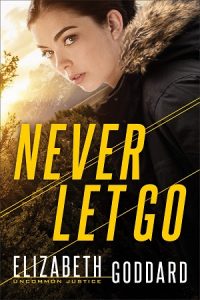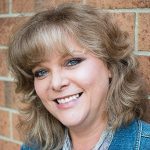The romantic suspense author on the challenges of balancing elements of faith, romance, and danger in her novels.
With more than 30 books published, Elizabeth Goddard has learned what it takes to write a fast-paced, emotional, and suspenseful page-turner. She ramps up the action and adventure once again in Never Let Go (Revell), the first book in the Uncommon Justice series. When forensic genealogist Willow Anderson stumbles into the middle of a decades-old abduction case, things are about to heat up. The case may be cold, but someone is determined to silence her forever to keep her from discovering the truth. In this interview, the author reveals the dinner table conversation that led to her new character, explains how forensic geologists help solve crimes, and reminds us why it’s important to know that God is always with us…
Elizabeth, Never Let Go is the first book in your new Uncommon Justice series. What inspired this story?
 Genealogy! I grew up in a family of amateur genealogists. The conversations around the dinner table were always about ancestors or what cemetery to visit next. Which old country church might have a registry or archives.
Genealogy! I grew up in a family of amateur genealogists. The conversations around the dinner table were always about ancestors or what cemetery to visit next. Which old country church might have a registry or archives.
Honesty, I listened only half the time, but I absorbed just enough to be dangerous. Ha! So, when I happened across an article about a forensic genealogist assisting the police, that immediately drew my attention. I knew that readers would also be riveted to the topic.
Willow Anderson is a forensic genealogist. What is that?
That was my question when I first saw the article! Think of it as genealogy research that’s conducted within a legal framework such as the search for missing heirs, determining kinship in adoption cases, citizenship issues. This list goes on.
Genealogy is also considered “forensic” when more scientific methods are used in research such as DNA analysis. Over the last couple of years, I’ve noticed that forensic genealogy is being used in both contexts when law enforcement commissions a forensic genealogist to analyze DNA from a cold case crime scene. If a family member has loaded their DNA onto one of the many genealogy DNA sites, then the forensic genealogist can then create a family tree.
The hope is that it will ultimately lead police to the criminal. That should serve as a deterrent to anyone even contemplating a crime!
What kind of research did it take to get the details right? (Any specific sources you can tell us about?)
 First, I read a book about forensic genealogy—and at the time, the only one I could find—Forensic Genealogy by Colleen Fitzpatrick. I had a kazillion conversations with an “expert” or rather I call her a genealogist extraordinaire.
First, I read a book about forensic genealogy—and at the time, the only one I could find—Forensic Genealogy by Colleen Fitzpatrick. I had a kazillion conversations with an “expert” or rather I call her a genealogist extraordinaire.
But in keeping with the tone and pacing I wanted for this story—a fast-paced romantic suspense—I didn’t want to bog the story down too much with the technical details. That would be a different kind of story. I learned far more information than I used in Never Let Go.
On the next page, Elizabeth tells us more about her leading man and leading lady. Click through to continue!


